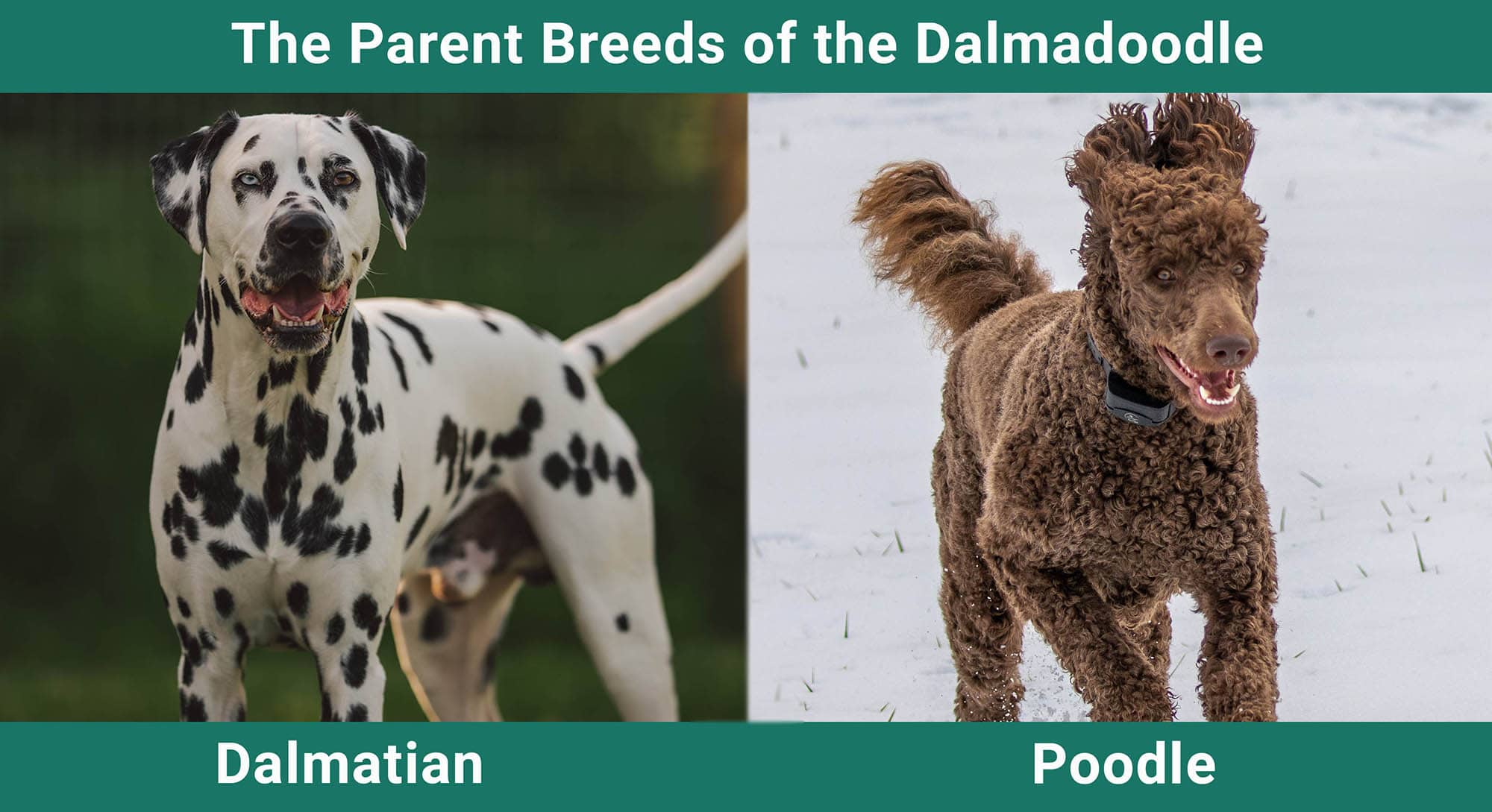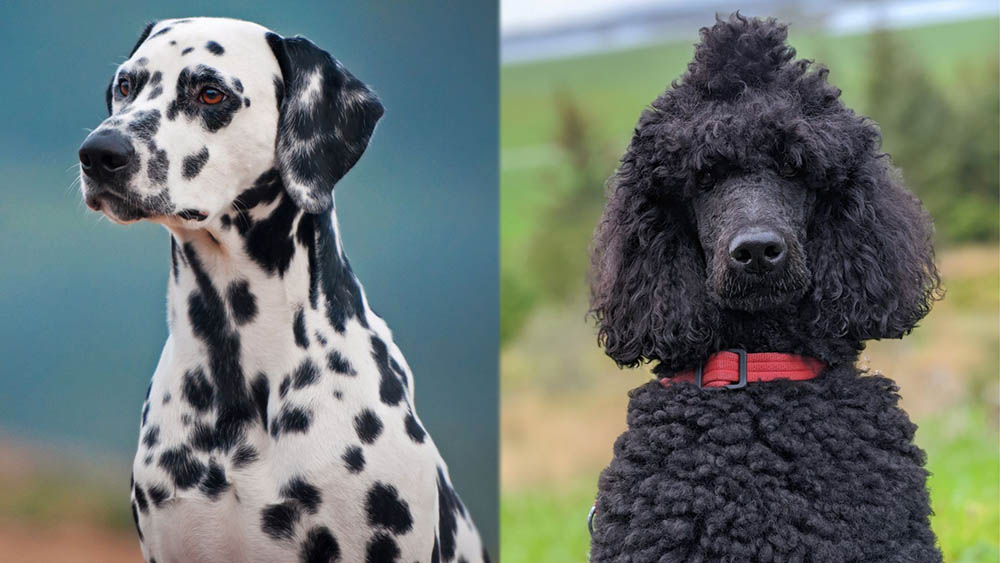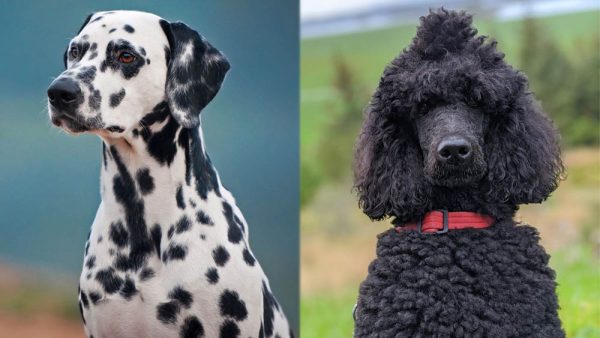Click Below to Skip Ahead
Mixing the traits and characteristics of a Dalmatian and a Poodle will undoubtedly create an intelligent, loving, and unique breed! This hybrid is known primarily as the Dalmadoodle but also goes by Dalmatianpoo, Dalmapoo, and Dalmatiandoodle.
If you are considering bringing a Dalmadoodle home, it’s important to know what to expect and what they need to live a healthy and happy life. In this article, we’ll discuss everything you need to know so that you can be the best parent.
Breed Overview
Height:
20–24 inches
Weight:
40–70 pounds
Lifespan:
11–14 years
Colors:
White and black
Suitable for:
Active families, owners willing to put in training
Temperament:
Energetic, intelligent, playful, loyal, loving
The Dalmadoodle is a mix of a Dalmatian and a Poodle, which are two spectacular breeds in their own right. The Dalmadoodle often inherits the distinctive black spots from their Dalmatian parent and a soft, fluffy coat from their Poodle parent, giving them a unique and very attractive appearance. These dogs carry themselves with confidence and pride. They offer amazing companionship, comical joy, an eagerness to please, and a willingness to learn.
Dalmadoodle Puppies
We can’t imagine anything more adorable than a fluffy, Dalmatian-spotted puppy! While the combination can vary, you will most likely have a puppy with spots. Dalmatians and Poodles are popular breeds and are generally easy to find from a reputable breeder. However, the mix is more specialized, so you will need to do some research on where to find one. You can speak to a breeder of either parent to point you in the right direction. If you are lucky and patient enough, you may find one of these gorgeous pups at a shelter or rescue center.
Like all puppies, Dalmadoodle puppies are full of energy and curiosity. They will need to be fed appropriate puppy food and kept safe from other larger pets. Although you can’t teach them advanced commands and tricks yet, you can begin training and socializing your Dalmadoodle puppy as soon as they settle in.

Temperament & Intelligence of the Dalmadoodle
If you’re familiar with the Dalmatian and Poodle, you have a good idea of the potential temperament of a Dalmadoodle. You will certainly have one of the most intelligent breeds, which can make for easy training, especially when starting young.
However, they may inherit the stubbornness of their Dalmatian parents, which may require extra patience and experience. The Dalmadoodle is an affectionate and loving breed. The confidence and alertness of their Poodle parents are likely to dominate, and you will certainly have a high-energy, playful, and extremely loyal pup.
Are These Dogs Good for Families?
Dalmadoodles are sociable dogs that make excellent companions for families. They get along with children and are happy to spend time with any family member. They are affectionate and loving but are not needy and demanding. Their loyalty makes them great guard dogs, but their initial weariness towards strangers makes early socialization essential.
When bringing home a new dog to a home with small children, it is vital to educate your kids on how to handle dogs and teach them what they should and shouldn’t do, like not disturbing them while eating or pulling at their tail. Supervising your kids and dog children during playtime is also important since a Dalmadoodle can unintentionally knock over a small child.
Does This Breed Get Along With Other Pets?
Dogs that grow up with other pets get along best, but Dalmadoodles are generally a sociable breed that will get along with other dogs, even if they haven’t grown up together. They will love having a friend to romp around and explore with, but your Dalmadoodle must be socialized from an early age to make introductions easier. Either way, introductions should be done gradually and never forced.
Poodles typically have a high prey drive due to their hunting history, so if this gene is prominent in your Dalmadoodle, you may need to be cautious around smaller dogs and cats.
Things to Know When Owning a Dalmadoodle
Dalmadoodles are remarkable dogs that make loving companions, but before you adopt one, you can learn more about their diet, exercise, and grooming requirements, and health concerns below.
Food & Diet Requirements
Your Dalmadoodle will thrive on a high-quality, well-balanced diet. You can speak to your vet about the best available brands, the correct portions for the size, breed, and life stage of your dog, and whether or not any supplementation will be necessary.
The portion size is especially important for your Dalmadoodle since they are energetic and will require the necessary amount of food to fuel them. Their weight also needs to be managed to prevent obesity which can affect their joints and lead to further health issues. Always ensure your Dalmadoodle has access to fresh, clean water daily, especially if it’s a hot day and your dog has been especially active.
Exercise
The Dalmadoodle is an active dog, regardless of which traits dominate from each parent. They need 30–60 minutes a day of exercise, including a walk, a run, or a trip to the dog park, and if there are more of the Poodle genes present, your Dalmadoodle may love to swim, which can be great exercise.
Dalmadoodles will also require mental stimulation, so you must include toys and games that allow them to use their intelligence. They also love interactive games and exercise with their owner, such as playing fetch and hiding games that enable them to use their noses.
Training
Dalmadoodles are incredibly smart and are generally easy to train, but there may be a streak of stubbornness and independence in some. Therefore, training will need to be consistent and firm, and as an owner of a Dalmadoodle, you will need to establish your role as the pack leader.
Training should start as early as possible, and a good routine should be established to maintain consistency. Positive reinforcement is the recommended method, so ensure you always have treats on hand and praise your dog every time they display a learned behavior.
Grooming ✂️
A Dalmadoodle can have a similar coat to their Poodle parent, which is curly and fluffy. However, it may be a little shorter because of the Dalmatian genes, which will determine how often they need to be groomed. Either way, your Dalmadoodle’s coat will require regular brushing to remove loose hairs and debris. It is also a good time to check your active dog for cuts, bumps, or sores.
Your Dalmadoodle’s teeth should be brushed often, but you can also provide chew toys and dental chews to maintain good dental health. Check your Dalmadoodle’s nails regularly for trimming; the general rule of thumb is that if you hear them tapping on the floor, they are too long. You also need to check their ears regularly for signs of infection and ensure they’re dry after swimming or bathing.
Health and Conditions
The Dalmadoodle has an average lifespan of 11–14 years, but of course, that is also dependent on their health and how well they are cared for. While Dalmadoodles are typically healthy canines, like all dogs, they are prone to certain health issues that all owners should be aware of:
- Allergies
- Eye issues
- Ear infections
- Addison’s Disease
- Cushing’s Disease
- Epilepsy
- Bloat
- Hip Dysplasia
- Urinary stones
It’s important to speak to your dog’s breeder about their health history and vaccination status. Ensure your Dalmadoodle gets a veterinary checkup at least once a year so that your vet can pick up any potential issues early. Keep up with your dog’s vaccination schedule and provide vet-recommended preventative medicines for fleas, worms, and ticks.
Male vs Female
Physically, the most significant difference between male and female Dalmadoodles is their size, and males are slightly larger than females. Regarding temperament, males are considered more independent and stubborn, and females are generally more affectionate. However, these are just generalizations, and a Dalmadoodle’s personality will depend on many factors. It is best to speak to the breeder as they know their litter best.
Whether or not your Dalmadoodle is intact will also make a difference in their behavior and health. Unneutered males will display unwanted behaviors such as mounting, hunting, and spraying and can sometimes become territorial. Unspayed females will have heat cycles twice a year. Having your dogs neutered and spayed will also help prevent unwanted litters and health issues such as uterine and testicular cancer.
 3 Little-Known Facts About the Dalmadoodle
3 Little-Known Facts About the Dalmadoodle
1. Dalmadoodles Can Make Great Swimming Companions.
2. Dalmadoodles are Mostly Spotted.
3. Dalmadoodles Love Having a Job to Do.

Conclusion
The Dalmadoodle is an incredible hybrid whose appearance certainly stands out! They are highly intelligent, naturally athletic, playful, affectionate, and loyal. They are relatively easy to train, but they might have a streak of stubbornness from their Dalmatian genes which may require a little extra patience. However, they are eager to please and will learn new tricks and commands fairly quickly.
The Dalmadoodle is an energetic pup that is ideal for active families that enjoy running, hiking, and swimming. With the correct training, socialization, and care, they can become loving family members for many years.
Featured Image Credit: (L) Maria Ivanushkina, Shutterstock | (R) Hans Ole Benonisen, Unsplash











